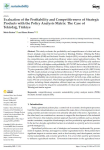Badem M., Hurma H. (2025). Evaluation of the profitability and competitiveness of strategic products with the policy analysis matrix: the case of Tekirdag, Türkiye. Sustainability, 01/06/2025, vol. 17, n. 11, p. 5112.
https://doi.org/10.3390/su17115112
https://doi.org/10.3390/su17115112
| Titre : | Evaluation of the profitability and competitiveness of strategic products with the policy analysis matrix: the case of Tekirdag, Türkiye (2025) |
| Auteurs : | M. Badem ; H. Hurma |
| Type de document : | Article |
| Dans : | Sustainability (vol. 17, n. 11, June 2025) |
| Article en page(s) : | p. 5112 |
| Langues : | Anglais |
| Langues du résumé : | Anglais |
| Catégories : |
Catégories principales 06 - AGRICULTURE. FORÊTS. PÊCHES ; 6.4 - Production Agricole. Système de ProductionThésaurus IAMM EVALUATION ; PRODUCTION AGRICOLE ; COMPETITIVITE ; PERFORMANCE DE CULTURE ; CEREALICULTURE ; BLE ; HELIANTHUS ANNUUS ; TURQUIE |
| Résumé : | This study evaluates the profitability and competitiveness of wheat and sunflower, strategic crops vital for food security, in Tekirdag, Türkiye. Utilizing the Policy Analysis Matrix (PAM) and Stochastic Frontier Analysis (SFA), we analyze their profitability, competitiveness, and production efficiency under current agricultural policies. The findings reveal positive private profitability for wheat (354.86 USD/ha) and sunflower (240.82 USD/ha), with higher social profitability (431.78 USD/ha for wheat, 641.39 USD/ha for sunflower) indicating inherent efficiency. Policy analysis shows wheat benefits from a 7% price protection (NPCO 1.07), while sunflower is implicit taxed at 20% (NPCO 0.80). The SFA results indicate average technical efficiencies of 79.9% for wheat and 88.9% for sunflower, highlighting the potential for cost reduction through improved input use. In this study, the profitability rate at private prices was about 16% for both crops, while sunflower had a 35% rate at social prices. These findings highlight the need for holistic agricultural policies, including climate adaptation, efficient input use, and market competitiveness measures, to ensure the long-term sustainability of wheat and sunflower production in Tekirdag and similar regions. |
| Cote : | En ligne |
| URL / DOI : | https://doi.org/10.3390/su17115112 |







